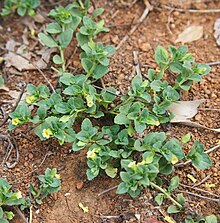
Buddleja is a genus comprising over 140 species of flowering plants endemic to Asia, Africa, and the Americas. The generic name bestowed by Linnaeus posthumously honoured the Reverend Adam Buddle (1662–1715), an English botanist and rector, at the suggestion of William Houstoun. Houstoun sent the first plants to become known to science as buddleja to England from the Caribbean about 15 years after Buddle's death. Buddleja species, especially Buddleja davidii and interspecific hybrids, are commonly known as butterfly bushes and are frequently cultivated as garden shrubs. Buddleja davidii has become an invasive species in both Europe and North America.
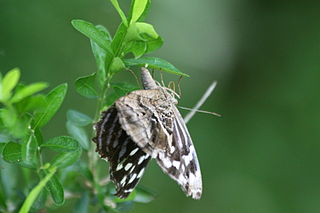
Adelia is a genus of flowering plants in the spurge family, Euphorbiaceae, subfamily Acalyphoideae. It is native to Latin America and the Caribbean, with one species extending northward into the southernmost part of Texas.

Calceolaria, also called lady's purse, slipper flower and pocketbook flower, or slipperwort, is a genus of plants in the family Calceolariaceae, sometimes classified in Scrophulariaceae by some authors. This genus consists of about 388 species of shrubs, lianas and herbs, and the geographical range extends from Patagonia to central Mexico, with its distribution centre in Andean region. Calceolaria species have usually yellow or orange flowers, which can have red or purple spots. The Calceolaria Herbeohybrida group, also called C. herbeohybrida Voss, is a group of ornamental hybrids known only in cultivation, called florists' slipperwort.
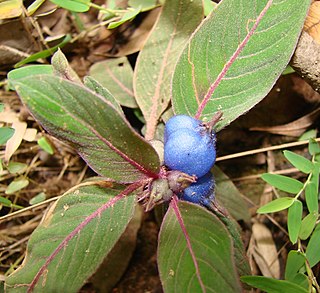
Coccocypselum is a genus of flowering plants in the family Rubiaceae. It is native to Mexico, Central America, the West Indies and South America. All species of the genus Coccocypselum are herbaceous with fleshy, blue or purple fruits, and 4-petaled flowers.

Capraria is a genus of flowering plants in the family Scrophulariaceae. It includes seven species native to the tropical Americas, ranging from Mexico through Central America, the Caribbean Islands, and northern South America to northern Argentina. It is sometimes placed in the families Gratiolaceae, Plantaginaceae, or Veronicaceae. The name is derived from the Latin word caprarius, meaning "pertaining to goats." This refers to goats being one of the few herbivores that will graze on the plants.
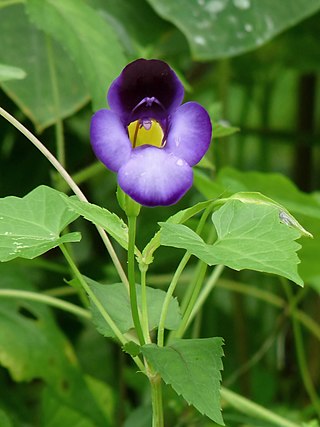
Torenia is a genus of plants now classified in the family Linderniaceae. Torenia has also been classified in the figwort family Scrophulariaceae. Often called wishbone flowers, bluewings; in Hawaii nanioola'a or ola'a beauty, some species are grown as garden plants. Many F1 and F2 Torenia hybrids have been hybridized in the last 30 years. Colors can range from white with yellow throats to violet, blue, cobalt, lavender and purple.

Galvezia is a genus of perennial plants which are native to western South America and the Galapagos Islands. The genus is currently placed in the family Plantaginaceae, having been formerly classified under Scrophulariaceae. It is named in honour of José de Gálvez, a colonial official in New Spain during the 1700s.
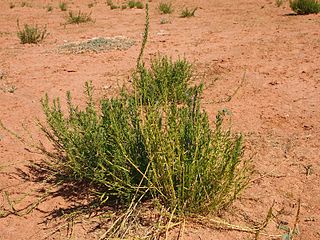
Stemodia is a genus of flowering plants in the family Plantaginaceae. The genus comprises approximately 45 species of annual and perennial herbs and shrubs which are distributed through tropical and temperate regions of the Americas, sub-Saharan Africa, the Indian subcontinent, and Australia. This genus is sometimes placed in the families Scrophulariaceae or Gratiolaceae. The generic name is derived from the Latin word stemodiacra, which means "stamens with two tips." Twintip is a common name for several species.

Asarina is a flowering plant genus of only one species, Asarina procumbens Mill. the trailing snapdragon, which is native to France and Spain and introduced in Germany, Switzerland, Austria and Hungary. Originally placed in the Scrophulariaceae, the genus has more recently been moved to the Plantaginaceae. Species from North America formerly placed in the genus Asarina are now placed in Holmgrenanthe, Lophospermum, Mabrya and Maurandya, as well as Neogaerrhinum. Asarina is now regarded as exclusively an Old World genus.

Maurandya is a genus of flowering plants in the family Plantaginaceae, native to Mexico and the south west United States. They sprawl or climb by means of twining leaf stalks. One of the four species, Maurandya barclayana, is widely cultivated as an ornamental plant.
Francis Whittier Pennell was an American botanist best known for his studies of the Scrophulariaceae. Employed by the New York Botanical Garden and then by the Academy of Natural Sciences of Philadelphia, he carried out botanical research in both North America and South America.

Holmgrenanthe petrophila is a rare perennial desert plant in the plantain family (Plantaginaceae), and the sole species of the genus Holmgrenanthe. It forms low mats of branched stems growing from a woody base. The leaves have small spines along their edges. The solitary yellow flowers are tubular with five free lobes at the end, the upper two pointing backwards, the lower three projecting forwards. The species is known only from about ten locations, most in the Titus Canyon and the adjacent Fall Canyon, all within the Californian section of Death Valley National Park. It grows in limestone crevices on the canyon walls, often on the north face.

Mabrya is a genus of flowering plants in the plantain family, Plantaginaceae. It consists of herbaceous perennials with brittle upright or drooping stems, found in dry areas of Mexico and the southern United States.

Matourea is a genus in the family Plantaginaceae. It includes nine species native to tropical South America and Nicaragua. The name Matourea refers to the town of Matoury.

Aureolaria flava, commonly called smooth yellow false foxglove or Gérardie jaune, is a species of plant in the broomrape family that is native to the eastern United States and some parts of southern Canada. Aureolaria flava is a species of flowering plants found within the genus Aureolaria. Aureolaria plants are hemiparasitic, which is a character that in part describes its residing family Orobanchaceae.
Escobedia is a genus of flowering plants belonging to the family Orobanchaceae.
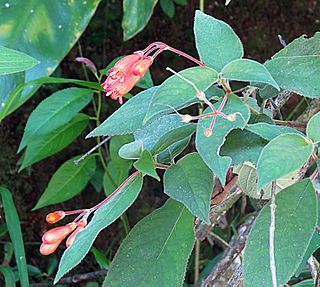
Moussonia is a genus of plants in the family Gesneriaceae. Its native range stretches from Mexico to Central America. It is found in Costa Rica, El Salvador, Guatemala, Honduras, Mexico and Panamá.

Ourisia microphylla is a species of flowering plant in the family Plantaginaceae that is endemic to the Andes mountains of southern Chile and Argentina. Eduard Poeppig and Stephan Endlicher described O. microphylla in 1835. Plants of this species of South American foxglove are small, showy, perennial, many-branched and suffruticose with entire, decussate leaves. The flowers are solitary, with a regular calyx, and a pink to white regular corolla. The calyx has tiny glandular hairs, and the corolla tube is glabrous inside.

Ourisia polyantha is a species of flowering plant in the family Plantaginaceae that is endemic to the Andes mountains of central Chile. Eduard Poeppig and Stephan Endlicher described O. polyantha in 1835. Plants of this species of South American foxglove are small, showy, perennial, many-branched and suffruticose with entire, decussate leaves. The flowers are solitary, with a regular calyx, and a regular corolla. The calyx has tiny glandular hairs, and the corolla tube is red, but yellow and glabrous inside.

Ourisia serpyllifolia is a species of flowering plant in the family Plantaginaceae that is endemic to the Andes mountains of central Chile. George Bentham described O. serpyllifolia in 1846. Plants of this species of South American foxglove are small, showy, perennial, many-branched and suffruticose with toothed, opposite leaves. The flowers are solitary, with a regular calyx, and a regular corolla. The calyx and corolla both have tiny glandular hairs. The corolla is violet, but the corolla tube is yellow and hairy inside.
